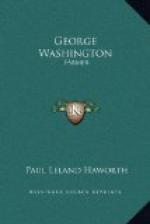CHAPTER VII
AGRICULTURAL OPERATIONS AND EXPERIMENTS BEFORE THE REVOLUTION
A detailed account of all of Washington’s agricultural experiments would require several hundred pages and would be tedious reading. All that I shall attempt to do is to give some examples and point the way for any enthusiast to the mass of his agricultural papers in the Library of Congress and elsewhere.
At the outset it should be stated that he worked under extremely different conditions from those of to-day. Any American farmer of the present who has a problem in his head can have it solved by writing to the nearest government experiment station, a good farm paper, an agricultural college, the department of agriculture, or in some favored districts by consulting the local county “agent.” Washington had no such recourse. There was not an agricultural college or agricultural paper in the whole country; the department of agriculture was not created until near the end of the next century; county “agents” were as unthought of as automobiles or electric lights; there was not a scientific farmer in America; even the Philadelphia Society for the Promotion of Agriculture was not founded until 1785. In his later years our Farmer could and did write to such foreign specialists as Arthur Young and Sir John Sinclair, but they were Englishmen unfamiliar with American soils and climate and could rarely give a weighty answer propounded to them by an American. If Washington wished to know a thing about practical farming, he usually had to find it out for himself.
This state of affairs accounts for his performing some experiments that seem absurd. Thus in the fall of 1764 we find him sowing “a few Oats to see if they would stand the winter.” Any country boy of to-day could tell him that ordinary oats sown under such conditions in the latitude of Mount Vernon would winter kill too badly to be of much use, but Washington could not know it till he had tried.
In another category was his experiment in March, 1760, with lucerne. Lucerne is alfalfa. It will probably be news to most readers that alfalfa—the wonderful forage crop of the West, the producer of more gold than all the mines of the Klondike—was in use so long ago, for the impression is pretty general that it is comparatively new; the fact is that it is older than the Christian era and that the name alfalfa comes from the Arabic and means “the best crop.” Evidently our Farmer had been reading on the subject, for in his diary he quotes what “Tull speaking of lucerne, says.” He tried out the plant on this and several other occasions and had a considerable field of it in 1798. His success was not large with it at any time, for the Mount Vernon soil was not naturally suited to alfalfa, which thrives best in a dry and pervious subsoil containing plenty of lime, but the experiment was certainly worth trying.




